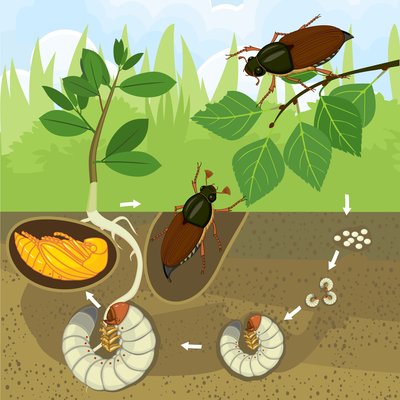Grubs lurk beneath the surface of the soil, where you likely won’t notice them until your lawn has severe damage. And now that spring is upon us; grubs will awaken from their winter slumber and begin feasting on your grass. But what exactly are grubs? Why are they bad for turfgrass, and how does grub control for lawns help? We’ll answer these frequently asked questions in this  month’s blog.
month’s blog.
Everything You Need To Know About Grubs
What Do They Look Like
Grubs are the larvae of Japanese beetles. These larvae are the white grubs that devour lawns. Their bodies are c-shaped with brown heads, visible legs and are approximately 1/8 to one inch in length. During their larval stage, they live beneath the surface. Fully grown Japanese beetles are about 1/3 to 1/2 inch in length with a metallic-green body and head copper-colored wing covers. White hair covers the sides and tips of their abdomens.
The Life Cycle Of Grubs
Adult Japanese beetles get nice and cozy underground over winter. When spring comes, their larvae instinctually move closer to the surface of the soil so that they can nourish themselves on the roots of turfgrass. Once they grow into adult beetles, they emerge in mid-summer and feed on the leaves of grass. Unfortunately, their activity causes the grass to create an odor that attracts more hungry beetles. This is why it’s so important to contact a lawn care service if you suspect you have grubs. It won’t take long before you have a full infestation. Catching them before the adults lay eggs, or these eggs hatch breaks up the cycle. Female Japanese beetles can lay as many as 60 eggs throughout their breeding season in late July and August. The eggs will hatch, and grubs dig deeper into the soil to wait for spring, where the cycle starts over again.
Signs Of Grubs In Lawns
You Notice Other Animals
Grubs are a staple food in the diets of birds, possums, raccoons, and skunks. If you notice more of these species than usual, it could be a sign of grub activity. These animals will dig up the turfgrass to get to the grubs just beneath the surface.
Dead Or Dying Grass
As grubs chew on the roots of the grass, the blades above the surface will start to brown, wilt, and die off, creating undesirable dead or brown patches in your lawn. Keep in mind that grub damage often has multiple symptoms, so don’t assume you’ve got grubs if the only thing you notice is brown grass. Brown spots in a lawn could be a type of lawn disease. If, however, you see dead grass in conjunction with the other signs we discuss, it could be time to consider grub treatment.
Your Turfgrass Is Loose Or Bumpy
As grubs munch their way through a lawn, it can create uneven terrain. They may also create spongy grass that feels like you’re walking on a yoga mat. Grub activity can also cause your grass to become so loose; it can be rolled back like a sod roll.
How To Get Rid Of Grubs
Like all insects, it’s impossible to eradicate the population. Having some grubs on your lawn does not mean the end of the world. However, ten or more per square foot is when you’ll start to  notice the damage. There are several ways of implementing do-it-yourself pest control.
notice the damage. There are several ways of implementing do-it-yourself pest control.
- Keep your lawn well-nourished with nitrogen fertilizer, as well as phosphorous and potassium. These are the three key ingredients to a healthy lawn.
- Keep the mower height between 2 and 3 inches. This promotes a healthy root system, which is less prone to grub infestation.
- Treat dead or dying areas with an overseeding application to restore damaged areas, and discourage more beetles from attacking the already stressed grass.
Sometimes, the infestation is more than one person can handle. Don’t wait until greedy little grubs fully take over your lawn. Occasionally contacting a professional grub control service is the most efficient means of eradicating grubs.
Get Rid Grubs With Help From Lawns-4-U
Don’t put up with destructive grubs on your lawn. The experts at Lawns-4-U are here to help! Our grub control program virtually eliminates these annoying beetles and their larvae so your grass can thrive. Give us a call today at 972-859-0658 or contact us online here! For more tips on lawn and garden care, pest control, and more, be sure to check out our monthly blog!
